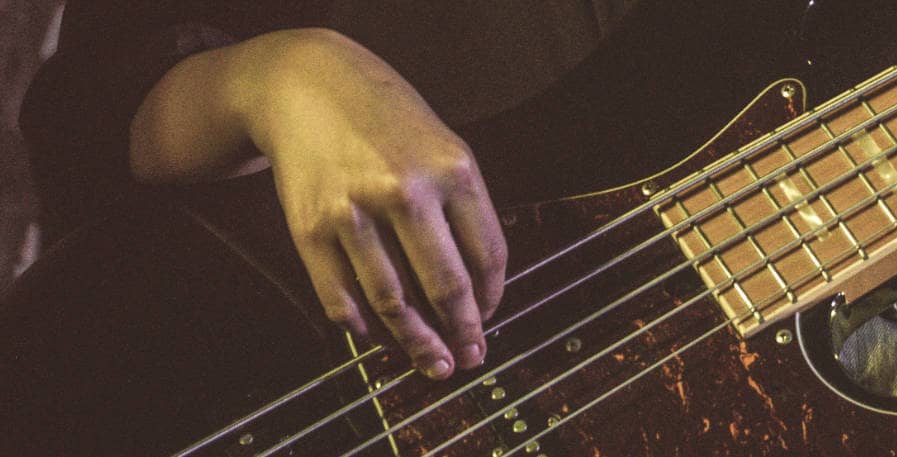The bass is a big instrument. Thus, having small hands can seem like a disadvantage for bass players. This is a common concern among beginners, and in some cases, this reason alone leads people to pick up a different instrument. But is it really a disadvantage, and do you need big hands to play the bass guitar?
Hand size is not detrimental to whether you can play the bass guitar, and many successful bass players have small hands. By developing their finger flexibility, technique, and by playing a bass that fits their physiology, bassists are able to play their instrument regardless of their hand size.
Thus, if you have small hands, don`t let that stop you from picking up the bass.
However, there are certain things you want to be mindful of if you decide to become a bassist. If you approach the instrument incorrectly, small hands can play a part in making the instrument difficult to play.
Therefore, I`ve written this guide to make your life as a bassist as easy as possible. Among other things, I will cover why you don`t need big hands, as well as how to set up your bass to fit your hand size. I will also cover how to develop your technique and hand flexibility, and what types of bass guitars will fit you the best.
Why you don`t need big hands to play the bass
The size of the bass guitar can make it feel cumbersome to play for beginners. Thus, it’s easy to think that the instrument would feel easier to play with bigger hands.
However, this has more to do with technique, hand positioning, and finger flexibility, than with your physiology. These are all things that can be learned and developed over time, and greatly diminish the importance of hand size.
Notably, there have also been countless amazing female bass players that have had long and successful careers.
An average-sized adult man has hands that are 7.6″, or 19.3cm on average. The average adult woman has hands that are 6.8″, or 17.3cm long. This length is counted from the joint where the palm and forearm meet to the tip of the middle finger.
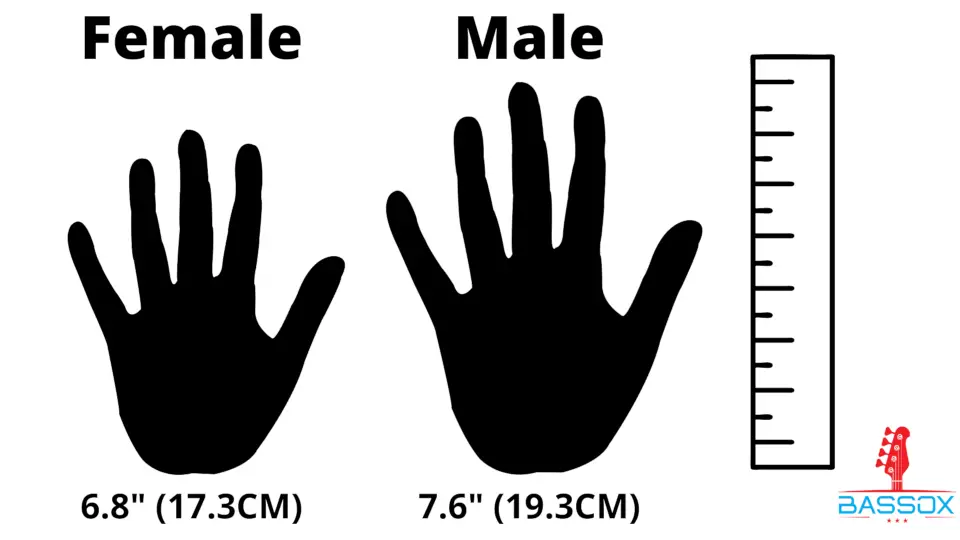
Furthermore, I`ve seen countless bassists less than half my age, who are significantly better at the bass than I am. Despite their hands not being fully grown, they are able to play the bass with good hand positioning and technique.
One of many examples is this cover of “ARETHA” by EllenPlaysBass. Here, she showcases how insignificant having small hands can be:
With that, I find it fair to say that having big hands is by no means a prerequisite for playing the bass at a high level.
Bass players with small hands
To me, Victor Wooten is one of the greatest bass players of all time. In addition to often being one of the most notable bassists of the 90s, his hands are noticeably on the smaller side.
However, this has not stopped him from writing some amazing bass lines and playing at an incredibly high level.
What`s more, is that he is not alone. Here`s a list of other bass players with small hands that have all had successful careers. These bassists all either have hands that are observably on the smaller side or have stated themselves that they have small hands:
| Bass player with small hands | Band | Notable songs |
| Victor Wooten | Béla Fleck and the Flecktones, SMV, Solo | Classical Thumb, The Sinister Minister |
| Carol Kaye | Session Musician | Good Vibrations (Beach Boys), Playing When I Die (Motherlode) |
| Flea | Red Hot Chili Peppers | Can`t Stop, Give It Away |
| Geddy Lee | Rush | YYZ, Tom Sawyer |
| Carl Radle | Derek And The Dominos, Session Musician | Layla, Bell Bottom Blues |
| Tina Weymouth | Talking Heads | Psycho Killer, This Must Be The Place |
| Matt Freeman | Rancid, Operation Ivy | Maxwell Murder, Radio |
| Steve Bailey | Session Musician, Solo | Roots To Branches (Jethro Tull), M.W.A (Musicians With Attitude) (David Benoit) |
| Bill Wyman | The Rolling Stones | Gimme Shelter, Under My Thumb, |
| Stuart Zender | ex-Jamiroquai | Cosmic Girl, Virtual Insanity |
Playing the bass with small hands
To make the bass easier to play with small hands, there are some things you should pay extra attention to. Here are the 4 main things I recommend focusing on.
1. Angle
The position of your fretting hand has a major impact on how far you are able to stretch your fingers. In extreme cases, the angle of your hand can make the difference in whether you are able to reach 3 frets or 5 frets.
The best way to avoid this is with proper thump positioning and keeping it behind the neck of the bass for support. Keeping at the side of the neck positions the whole hand at an awkward angle which greatly limits the reach of your fingers.
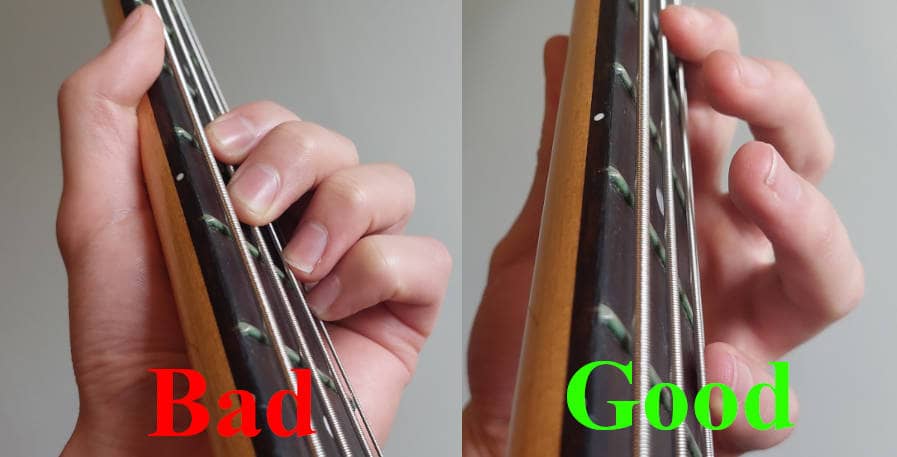
It`s fine for your thumb to move around a little and bend at different angles when you play. This will naturally happen as you move around the neck and need to reposistion your hand.
However, these movements should bekept as slight as possible, and the thumb should always be anchored at the back of the neck. As a result, your fingers will naturally be positioned at an angle where you more reach and better control over the fretboard.
2. Stretching
As you play the bass, you will naturally stretch your fingers. Thus, In time,you will become more accustomed to finger positions that feel unatural when you first pick up the instrument.
In addition to playing, you can also do hand strecth exercises. These exercises can increase the speed at which you develop the reach of your fingers. As an added bonus, they are also great for preserving the health and condition of your hands.
If you at any point experience pain during these stretches, stop doing them immediately. Consult with a medical professional if you experience prolonged hand pains from playing the bass guitar or bass-related exercises.
Here are two stretches that have helped me through the years.
The first of these consists of using your other hand to stretch the fingers on your hand backward. This should at no point in time feel painful, and you should feel a nice stretch in the joints at the back of the fingers.
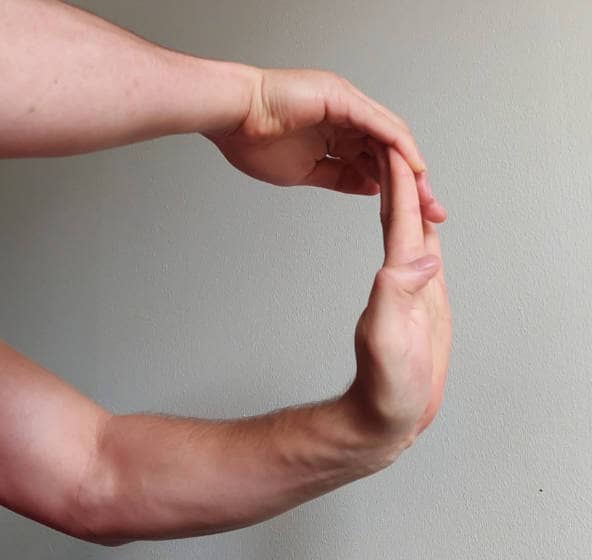
The other exercise is an inversion of the first one. Angle your hand downwards and use your other hand to stretch the fingers backward. Position the other hand below the lower joints of the stretched hand, so that you can stretch the entirety of the fingers.
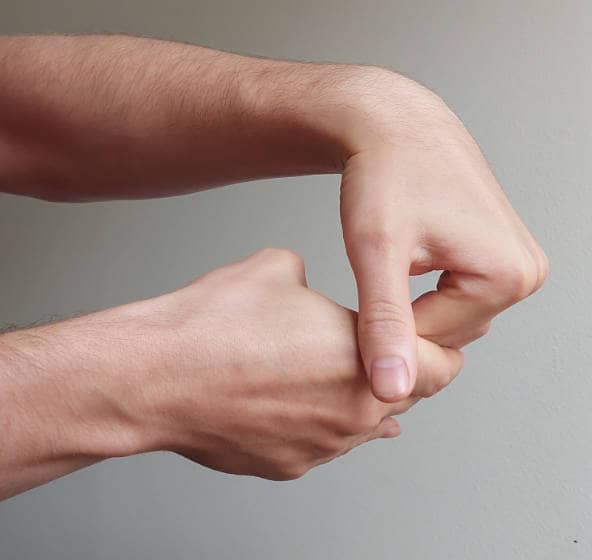
For both exercises, holding the position for about 10 to 15 seconds will be sufficient. I prefer doing them before and after I play my bass. This has the added benefit of reducing the muscle tension from playing, in addition to developing the flexibility of the fingers.
3. Avoid unnecessary movement
This is a common beginner mistake, regardless of hand size. However, it is easier to get away with unnecessary hand movements with big hands.
First of all, you should keep your hand in the same spot when you don`t need to move it. This enables you to reach 4 different frets, by using a different finger for each of them. This way, you can easily reach almost all of the notes in the 12-step chromatic scale.

Thus, try not sliding your hand across the neck whenever you are playing a groove that can be played within 4 frets. Avoid contorting your hand, or make great shifts in your hand position to reach notes when doing so.
While moving your hand and thumb slightly is fine if you physically cannot reach a fret otherwise, do not make these movements longer than they need to be.
When you need to move up or down the fretboard, it is also preferable to slide across it, rather than lifting your hand off the fretboard to reach the new position. While this can feel unnatural at first, this will make your technique more fluid and speed up your playing in the long run.
4. Play with a floating thumb
If you pluck the strings with your fingers, playing with a floating thumb is generally preferable to playing with a movable anchor.
This means that instead of resting your picking hand thumb on the pickup or the strings, it is kept loose and unanchored. As a result, your hand can move around more freely and naturally than if it was resting on a string or the pickup.
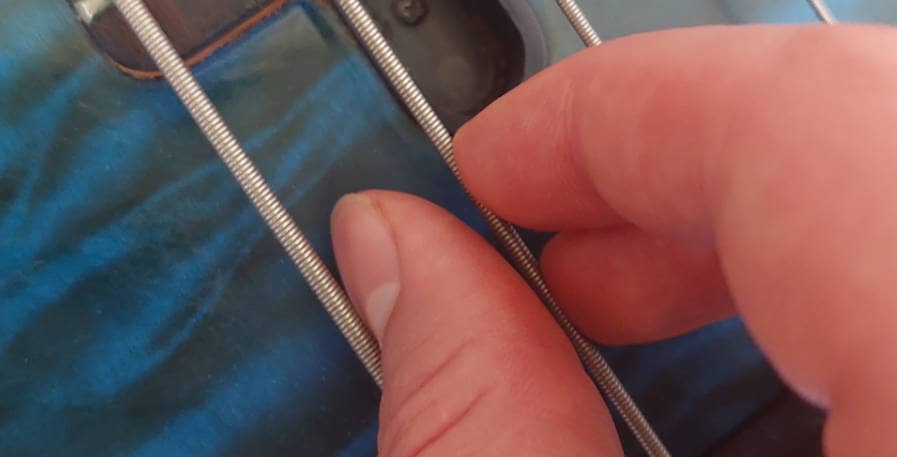
The reason this is helpful for bassists with small hands is that when you anchor your thumb on the pickup you have to reach longer to play the D and G strings. This can lead to awkward hand positions, an inconsistent tone, and even result in your injuries in the long run.
With a floating thumb though, you never have to reach with your fingers. If you have to play the G string, you simply move your hands and the thumb follows. Thus, while it will take time to become proficient at playing with a floating thumb, the time investment will generally be worth it.
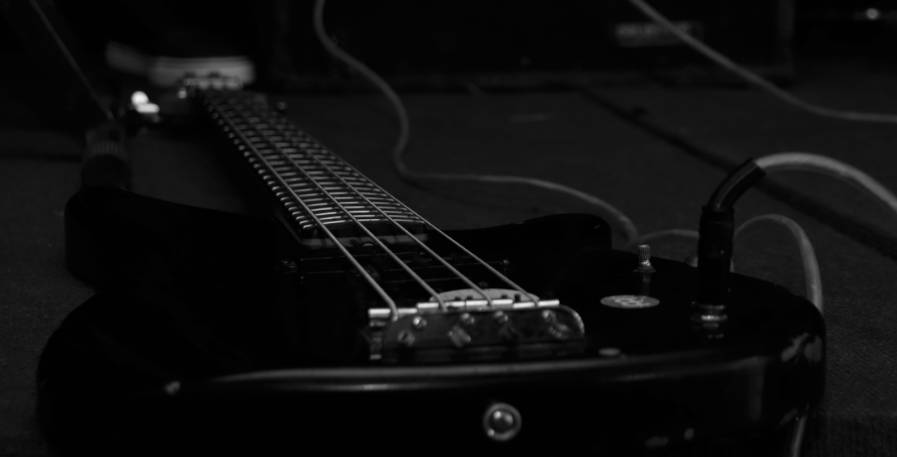
Setting a bass up for small hands
In addition to developing your technique and stretchibility over time, there are some steps you can take to immidatley make your bass easier to play. These steps have to do with setting up your bass, and make a big difference in how comfortable it feels to play.
Lower the action
Action refers to the space between the strings and frets on a bass. A bass with low action will generally feel easier to play, as you don`t have to work as hard to fret strings.
This enables you to play for longer periods of time as your fingers won`t become tired as quickly. Low action also enables you to play faster as fretting strings won`t take as much time, and playing notes in succession feels more fluid.
There is a limit to how low you can set the action, as having the strings too close to the frets will cause a static sound. However, if you notice that there is a noticeable amount of space between the strings and frets, lowering the action can greatly improve the playability of your bass.
You can lower the action on a bass yourself. It is also possible to have a luthier set up the bass with lower action for you.
Use lighter gauge strings
Similar to setting the action low, switching to a thinner set of strings can make the neck of the bass faster and smoother to play. This is because the strings will wear down your fingers less, and feel less cumbersome to fret.
Common bass strings tend to have gauges of about 105-85-70-50. Thus, switching to a set such as 100-80-65-45 can feel more comfortable if you have small hands. If you play in E standard tuning, I do not suggest going much thinner than that, as strings will start to feel overly tense past these gauges.
Bear in mind though, that this will change the tone of your instrument. It will sound less resonant, and mid and high frequencies will be more pronounced, while low frequencies will be less noticeable.
Thus, some bassists elect to play thin strings for their tone, while others stay away from them for the same reason.
Switch to a thinner neck
While a more costly and time-consuming step, switching to a thinner bass neck can make your bass more fitting for your body.
Playing a bass with a narrower and thinner neck makes it easier to grip and control it. In turn, playing the instrument won`t feel as cumbersome or overwhelming as with a thicker neck.
Bass necks differ greatly in price. For a general range, expect to pay somewhere between $75 and $150 for a new neck.
There is also the additional cost of having a luthier switch the neck. You can switch out a bass neck on your own, but this will require some woodwork, drilling, and precise measuring.
Thus, switching necks can be both costly and time-consuming. I am mentioning it because it can be a viable option for bassists that already own a bass, and want to make it more fitting to their physiology without switching to a new bass.
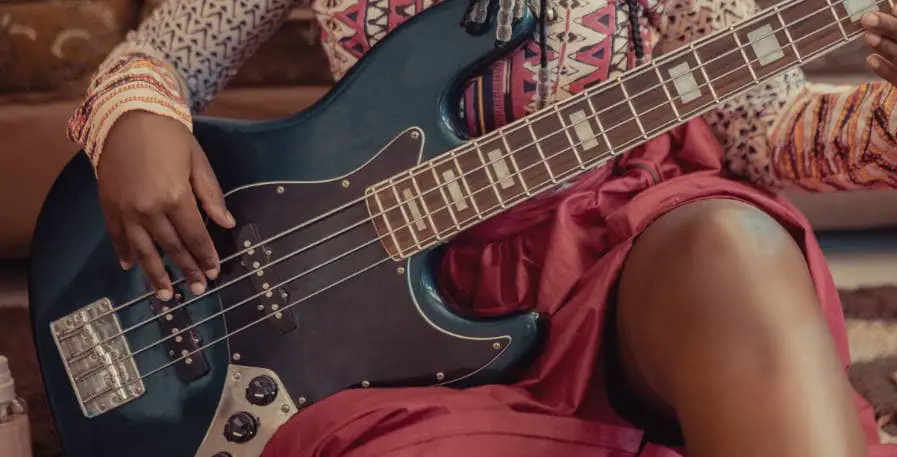
Choosing a bass for small hands
You can still play a 5 or 6-string bass with small hands. However, 4-strings will generally be more suitable, namely because they have thinner necks, which makes reaching strings easier.
As for 4-string basses, both long-scale basses and short-scale basses are a great fit if you have small hands.
Long-scale basses
While having small hands won`t make long-scale basses unplayable to you, some models feel more difficult to play than others.
The most notable example of this is the Fender Precision bass. It is a tried and true instrument that is mostly beginner friendly. However, it has wide string spacing and a relatively thick neck.
Thus, when I compared the jazz and precision bass for beginners, I concluded that the jazz bass could be a better fit for bassists with small hands.
This was in large part due to the width of the neck at the nut, where the precision is 1.69″ (43mm), and the Jazz is 1.5″ (38mm). For this reason, some bassists also elect to switch out the neck on their precision bass and play a J neck with a P body.
This is the same reason why I wouldn`t recommend playing a 5 or 6-string. While 5-string necks are often thin, they are also wider and necks are commonly ~1.77″ (45mm).
Many long-scale basses have necks similar to that of the Fender Precision. Thus, here is a list of some common basses with thinner necks that you might find suitable.
| Bass Guitar | Neck Width in Inches | Neck With in MM |
| Ibanez SR | 1.5″ | 38.1mm |
| Fender Jazz | 1.5″ | 38.1mm |
| Gibson Thunderbird | 1.6″ | 40.6mm |
| Lakland 44-64 | 1.5″ | 38.1mm |
| ESP LTD* (Model dependant) | 1.57″ | 39.9mm |
| Squier Jazz | 1.5″ | 38.1mm |
Short-scale basses
Short-scale basses generally have a scale length of 28.6″ or 30″, which is the same as 73 & 76cm. This makes them noticeably shorter than long-scale basses, which have a scale length of 34″, or 86cm.
The short-scale bass is a great instrument for beginners. Many of the same reasons that make the instrument beginner-friendly, also make it fitting for bassists with small hands.
The two main reasons for this are that frets are easier to reach and to fret.
As the neck is smaller overall, it can feel more natural to stretch your fingers across frets and to play octaves. Thus, if you have tried playing a 34″ scale bass and felt that your fingers were barely out of reach of the frets you wanted to play, you might prefer the size of a short-scale bass.
The strings are also less tense than on a long scale, which results in them being easier to fret. As a result, they are less demanding on the fingers and can make switching between notes easier.
Thus, while small hands won`t prevent you from being able to play a long-scale bass, you might find that the short-scale bass fits you better. You also won`t have to put as much emphasis on your neck size as with the long-scale, as all short-scale basses are sufficently thin.
What`s left to consider then, is whether you like the playability, look, and sound of short-scale basses. The looser feel of the strings is not for everyone, and may or may not feel comfortable to you. Furthermore, short-scale basses tend to have a darker tone and be more low-end heavy than long-scales.
Conclusion
As you can tell by now, having big hands is far from as important for playing the bass as some make it out to be.
There are countless young and female bassists that are far greater at this instrument than I will ever become. On top of that, Victor Wooten is one of the best bass players I have ever heard, and he has showcased that the bass can be played at the highest of levels with small hands.
To make the bass easier to play, it can be beneficial to set the action low and to use light strings. This makes fretting and reaching strings easier, which in turn makes hand size less detrimental.
You also want to ensure that your thumb is anchored at the back of the bass and that you have a natural and wide grip of the fretboard. By regularly stretching your hands and playing with a floating thumb, reaching strings becomes easier as you develop your flexibility and technique.
A Long-scale bass with a thin neck or a short-scale bass will genereally fit your physicology the best. While you can still play a 5 or 6-string bass, or a bass with a thick neck such as the Fender Precision, these basses could feel more cumbersome to play overall.

